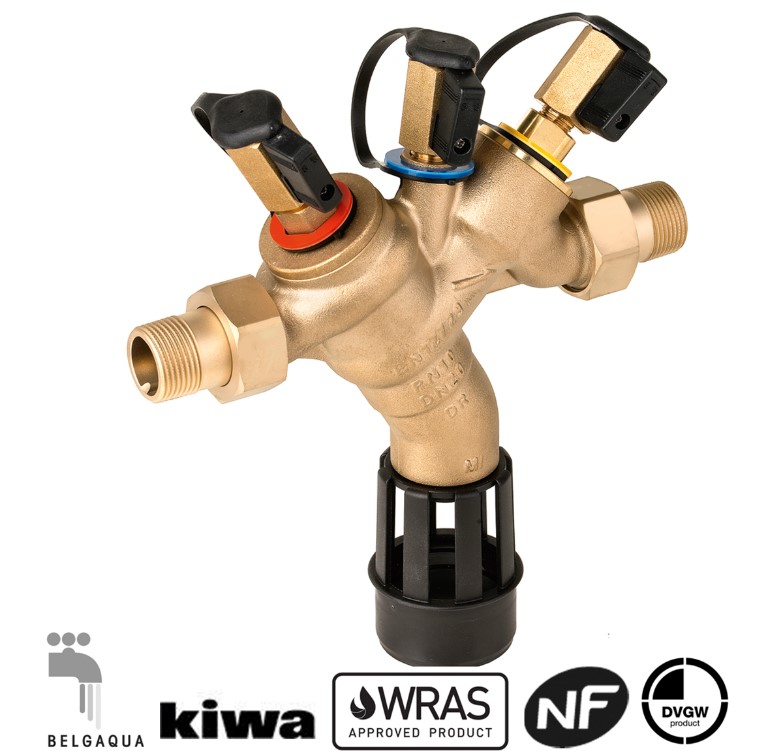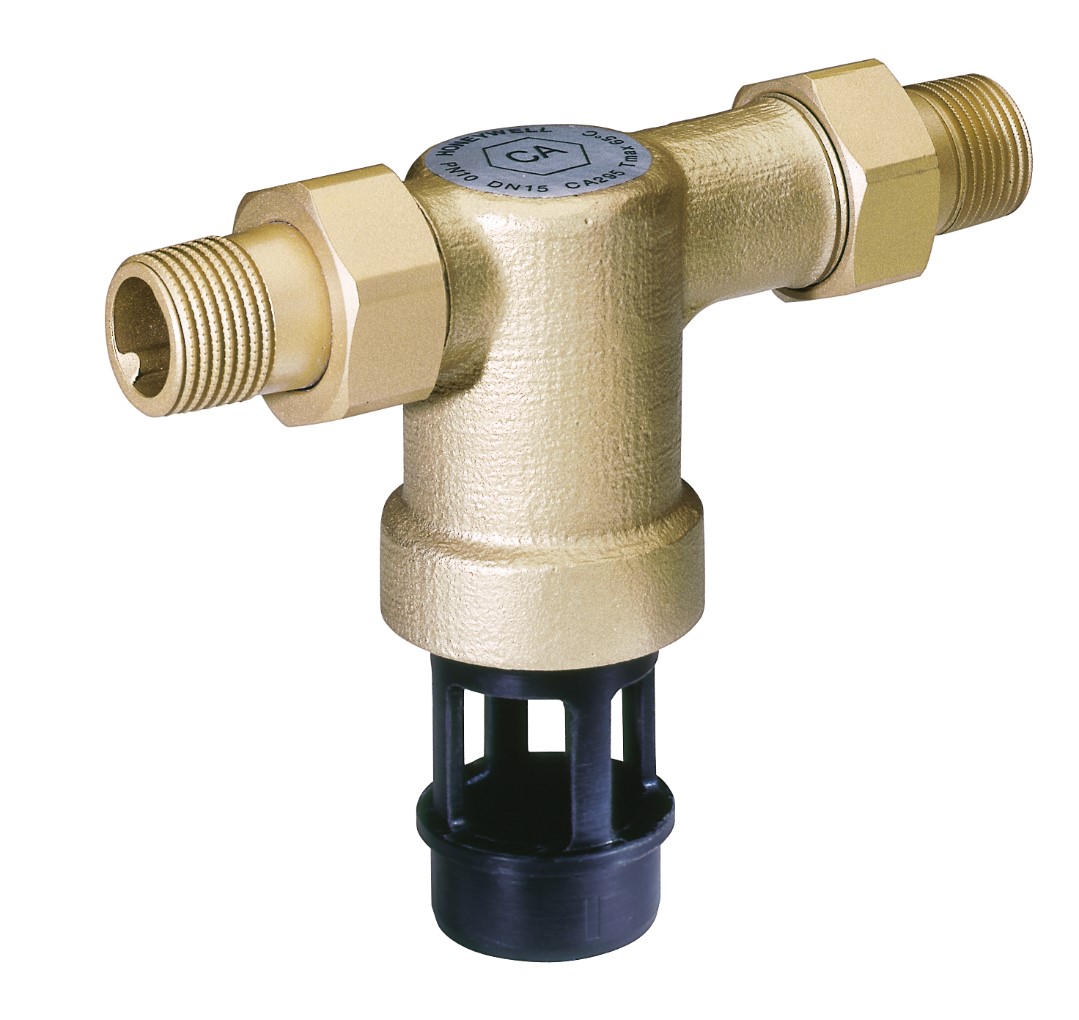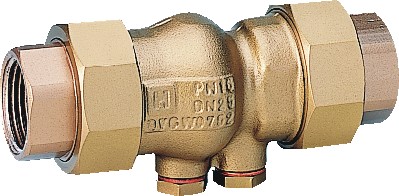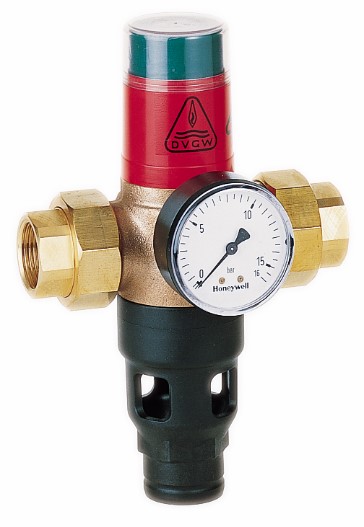The possibility of reverse flow is currently one of the greatest threats occurring in water installations and water supply networks. It may be caused by a drop in pressure or back pressure outside the system. As a result, water intended for human consumption may be contaminated. To eliminate such risk and ensure its high quality, anti-contamination valves should be used.

If you want to learn how an anti-contamination valve works and how to protect your installation against backflow, read our article. You will learn how to use backflow isolators for households, public facilities and industrial systems.
From the article you will learn:
- How the law regulates drinking water quality issues.
- What are the functions of the anti-contamination valve?
- Which models of Resideo anti-contamination valves are worth choosing for various installations.
Legal issues regarding the quality of drinking water
Regulations regarding water supply installations were introduced in Poland by the PN-92/B-01706 standard of 1992. It includes the requirement to install non-return valves to protect the pipeline against the effects of changes in the direction of water flow. However, the regulations did not mention anti-contamination valves. The obligation to use them was imposed only in 2000 by the Regulation of the Minister of Internal Affairs and Administration.
In 2003, the PN-EN 1717 standard came into force, i.e. "Protection against secondary water pollution in water supply installations and general requirements for devices preventing contamination by backflow". It imposed an obligation on users of water installations to protect them against possible contamination.
Therefore, not only water supply companies, but also individual users of installations should take care of the quality of drinking water. To prevent contamination due to backflow , high-quality anti-contamination valves should be used.
Resideo valves in the wholesale offer
Tasks of anti-contamination valves
How does reverse flow occur? On the one hand, such a threat occurs when the pressure in the water supply system drops. This can happen when lines break, high draws occur, or pumps don't work properly. This phenomenon is called reverse leverage . On the other hand, water supply contamination may result from backflow under pressure. Its source is outside the water supply system.
If one of these situations occurs, drinking water is protected against secondary contamination by anti-contamination valves. They fulfill their task by, among other things, using an air gap located between the lowest point of the water supply hole and the maximum fluid level in the tank. Depending on the type, flow isolators may also use mechanical disconnection or naturally aerate the installation through atmospheric pressure.
Types of anti-contamination valves
Before we move on to individual products, it is worth characterizing the main types of anti-contamination valves . Top-down regulations precisely define the technical construction of given types and their permissible use. The most common of them are:
- Type BA – high-class backflow isolators, enabling supervision of water flow. They are used in both residential buildings and public buildings. They are chosen primarily because of their excellent security quality.
- Type CA - non-monitorable valves, installed, for example, in heating installations or cooling systems.
- Type EA - valves sensitive to pressure changes, installed in particular with regulators and filters of various types. They provide the possibility of supervision.
Anti-contamination valve - installation
When installing anti-contamination valves, it is worth remembering a few rules that will ensure their functional operation. First of all, they should be installed on a horizontal section of the installation, with the drain valve facing down. If the inlet pressure fluctuates or the level exceeds 10 bar, a pressure regulator should be placed upstream of the isolator. For easy inspection and service, it is worth providing convenient access to the valve.
The anti-contamination valve should not be located in a location potentially at risk of flooding. The place of installation must also be properly protected against low temperatures and ventilated. During normal operation of the installation, the BA valve may discharge a certain amount of water to the outside through the drain connection, therefore it should be provided with an optimally sized drain, preferably permanent and dedicated to the insulator. Remember that there must be no unprotected drinking water connection behind the valve.
BA295S backflow preventer - application, properties and principles of operation

The Resideo BA295S anti-contamination check valve from Resideo is characterized by the use of a reduced pressure zone. It is used both in residential buildings and in industrial and commercial facilities. According to the specifications in accordance with the PN-EN 1717 standard, it provides protection up to pollution class 4.
The BA295S valve guarantees optimal protection of the water supply system. This model is characterized by a built-in filter at the inlet and a valve insert that also serves as an inlet non-return valve and a drain valve. The undoubted advantages of the insulator include its compact design and simple service. The design of the valve provides convenient/easy access to all internal components without the need to dismantle the valve from the pipeline. All internal parts can be easily accessed. The valve guarantees low pressure losses and high throughput. How exactly does it work?
The Resideo BA295S anti-contamination valve is a direct-acting device with three separate pressure zones. It is highest in the inlet chamber, lower in the middle chamber, and lowest in the outlet chamber. There is a drain valve connected to the middle chamber, which opens when the difference between the first two zones drops to 0.14 bar. Water from the middle chamber flows out and non-return valves close the flow. Thanks to this, the middle zone is separated from the inlet and outlet zones. The water flow is interrupted and the installation is protected against contamination.
The BA295S anti-contamination valve has PZH approval as well as prestigious DVGW and WRAS certificates.
Lead-free backflow isolator BA295S-LF - application, properties and principles of operation
Resideo's BA295S-LF lead-free anti-contamination valves are almost identical in operation and design to the isolators discussed above. The feature that distinguishes them from anti-contamination valves available on the market is undoubtedly the body and threaded connections made of lead-free material. BA anti-contamination valves of this type are characterized by an optimized design that prevents the formation of dead zones in which water could stand. These are products that have PZH approval and are compliant with the REACH and RoHS directives. They are also TÜV LGA approved for low noise levels.
BA295S-LF anti-contamination valves can be used in multi-family buildings and various public facilities. They provide protection up to pollution class 4.
See Resideo products at the Onninen wholesaler
CA295 anti-contamination valve - application, properties and principles of operation

CA family isolators work similarly to BA type anti-contamination valves. They also use a reduced pressure zone. They are used to protect drinking water installations against contamination as a result of reverse flooding or pressure return flow. In accordance with the specification of PN-EN 1717, the valves comply with type 2 design recommendations and guarantee protection up to risk class 3.
Due to the technical properties of CA295 anti-contamination valves - unlike types BA and EA - they are used in particular to protect power supply installations in industrial applications. They have a built-in filter and are characterized by a compact design, making access to all internal parts very easy and convenient. One of their greatest advantages is triple protection - they have two check valves and a drain valve, which divide the insulator into three zones. It is worth noting that the CA295S anti-contamination valves have the PZH certificate and the prestigious WRAS certificate.
The principle of operation of CA295 anti-contamination valves is similar to that of BA295S. The insulator is divided into three chambers: inlet, middle and outlet. When the pressure difference between the first two zones drops below 10% of the inlet pressure, the drain valve will open and allow water to flow out of the middle chamber. In this variant, measurement is impossible.
EA type anti-contamination check valve with threaded connectors RV281 - application, properties and principles of operation

Anti-contamination valves from the EA family operate in a slightly different way than BA or CA products. They are used primarily in connection with pressure regulators, filters and filters with regulators. They are used wherever the water installation must be protected against backflow. They are suitable for use in multi-family buildings as well as in industrial or commercial systems. They successfully protect pipelines against the effects of backsealing and pressure backflow. They guarantee protection up to category 2 liquids.
The EA RV281 anti-contamination valve has a number of beneficial properties. Its greatest advantages include the above-mentioned versatile use and low pressure losses. Check valves of this type are very easy to install and service. The position in which they are installed ensures optimal water drainage and convenient access to parts. The insulator operates very quietly and does not cause water hammer. How does it work?
RV281 anti-contamination valves have a movable valve head pressed by a spring and changing position depending on the water flow. If this begins to fail, the spring presses the plug against the valve seat, cutting off the flow direction. In this way, the water supply network is protected against contamination.
RV281 anti-contamination valves have PZH and DVGW approval.
GA-R295 direct acting disconnector - an alternative to the traditional anti-contamination valve

Direct acting switches play the same role as traditional anti-pollution valves. The structure of the GA-R295 model complies with the design recommendations of type 1 according to the DIN 1988 standard and guarantees protection up to risk class 3 in accordance with the PN-EN 1717 standard . It is also worth noting that this model has a PZH certificate.
See Resideo products in the Onninen store
The direct acting switch operates on a very simple principle of pressure balance. Like an anti-contamination valve, it cuts off the water flow when the pressure in the installation drops. The switch moves from the closed position when the inlet pressure drops so much that it no longer resists the spring force. In such a situation, it moves the piston up, cutting off the flow direction at the same time. Thanks to this, any failure causing a pressure drop (such as a pipe burst) will not result in water contamination.
Due to their reliability, direct-acting switches are commonly used in power supply systems of production, service and commercial buildings. In water installations, they are installed in places exposed to contact with fluid from risk category 3. They constitute the main protection at the connection to the water supply network. It is recommended to install them in the power supply systems of facilities such as baths and showers with movable spouts, garden sprinkler connections, automatic beverage dispensers, water heaters and air conditioning devices.
Another valve worth considering is the GB-R295 model, which provides protection up to risk class 4 (toxic and very toxic, carcinogenic and radioactive substances). This unique solution, similar to the BA Series valves, is used to protect drinking water systems from the potential for contamination due to back-leaving or pressure backflow, while also ensuring reduced water consumption.
Optimal protection of drinking water installations – Braukmann check valves
If you are looking for a reliable anti-contamination valve for your water supply network, check out the Braukmann product family from Resideo , which was spun off from Honeywell in 2018. Valves from this manufacturer can be used in any type of installation, protecting drinking water against contamination due to possible reverse flow. These small threaded elements are made of high-quality materials, such as galvanizing-resistant brass, durable plastics or EPDM rubber approved for use in drinking water systems.
As a result, Braukmann anti-contamination valves are characterized by above-average durability and resistance to intensive use in demanding environments. Thanks to the use of the latest technologies, they protect water against secondary contamination, regardless of the type of installation and type of building. Anti-contamination valves from the Resideo offer are a mandatory element of every water supply system.
Anti-contamination valves for every installation
When choosing anti-contamination valves for your installation, pay attention to the certificates and approvals they have. They prove that these products meet a number of technical conditions required by national and European standards. Select an insulator according to the type of building, type of installation and one of five categories of contamination risk. Braukmann valves from the BA, CA and EA families, as well as GA direct-acting disconnectors, will protect any water supply installation.